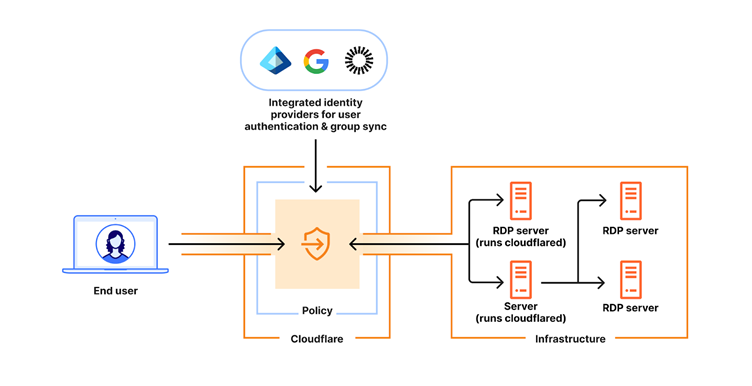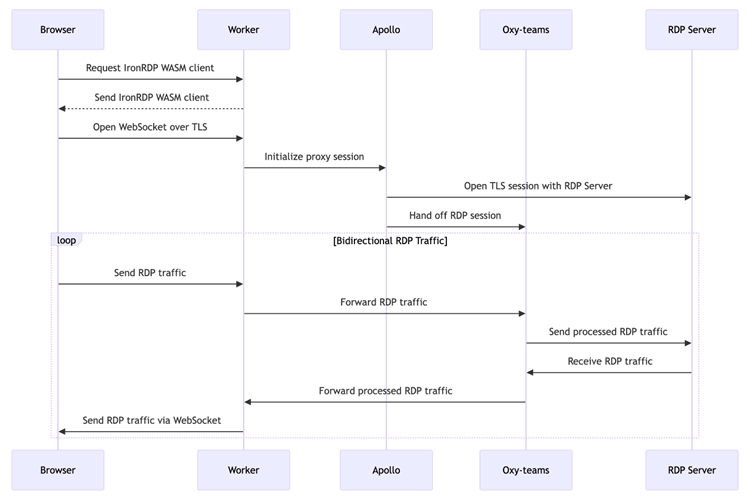Cloudflare has introduced a groundbreaking browser-based Remote Desktop Protocol (RDP) solution. This innovative tool allows users to securely access Windows servers directly from their web browsers, eliminating the need for native RDP clients or VPNs.
Cloudflare’s browser-based RDP solution is part of their Cloudflare Access suite, which already includes clientless SSH and VNC offerings, aiming to provide a seamless and secure experience for remote work.
Remote Desktop Protocol (RDP) has been a staple for remote access since its inception with Windows NT 4.0 in 1998.
Despite its utility, RDP has faced significant security challenges. Early vulnerabilities, such as weak user sign-in credentials and unrestricted port access, have made RDP servers vulnerable to brute force attacks and credential stuffing.
Notable security incidents include the BlueKeep vulnerability (CVE-2019-0708), which allowed unauthorized remote code execution and was wormable, spreading across networks without user interaction.
Moreover, RDP has been linked to the deployment of ransomware like Ryuk, Conti, and DoppelPaymer, earning it the nickname “Ransomware Delivery Protocol.”
However, with advancements in Windows security patches and better password hygiene, many organizations have mitigated these risks. Still, unpatched systems remain, posing ongoing threats.
The Need for a Secure Browser-Based RDP Solution
Despite its risks, RDP remains essential for organizations, particularly those with distributed workforces relying on high-powered Windows servers for compute-intensive tasks. It offers valuable visibility into user actions and server access.
For contractors using personal devices under BYOD policies, traditional RDP is impractical due to the need for client software on each device.
Prior to Cloudflare’s solution, organizations had to rely on third-party tools like Apache Guacamole or Devolutions Gateway for browser-based RDP access.
These tools introduced operational complexity, maintenance burdens, compliance challenges, and added infrastructure overhead.
Cloudflare’s Browser-Based RDP Solution
Cloudflare’s new solution addresses these challenges by offering a high-performance RDP proxy built into their global network.
This requires no additional infrastructure and leverages IronRDP, a modern RDP client written in Rust, to provide an efficient browser-based experience.

Here’s how it works:
- Client Setup: Users access RDP servers through a browser using the IronRDP client. The client encapsulates RDP sessions within a WebSocket connection, secured over HTTPS, enabling communication with Cloudflare’s RDP proxy.
- Security and Authentication: Cloudflare utilizes modern security controls, including fine-grained policies for Single Sign-On (SSO), Multi-Factor Authentication (MFA), and dynamic authorization. RDP sessions are encrypted and authenticated throughout Cloudflare’s network.
- Server-Side Proxying: The WebSocket connection is received by a dedicated proxy built using Cloudflare Workers. This proxy authenticates and terminates the connection before routing it through Apollo, a service managing traffic flow within Cloudflare’s network.
- Policy Enforcement and Monitoring: Cloudflare’s secure web gateway, Oxy-teams, enforces Layer 4 policies and monitors RDP traffic, providing administrators with comprehensive logs and visibility.
Key Benefits and Future Enhancements

Cloudflare’s browser-based RDP solution offers several key benefits:
- No Additional Software Needed: Users can access Windows servers directly from a web browser, eliminating the need for VPNs or native RDP clients.
- Low Latency: Cloudflare’s global network reduces latency, ensuring a responsive experience.
- Enhanced Security: Access is protected by zero-trust policies, preventing unauthorized access and lateral movement.
- Integrated Logging and Monitoring: Detailed logs support regulatory compliance and security audits.
Future enhancements will focus on advanced session monitoring and data loss prevention (DLP) features to restrict actions like file transfers, further securing data integrity.
Additionally, Cloudflare plans to introduce passwordless authentication, reducing the complexity of managing long-lived credentials.
With this innovative solution, Cloudflare is redefining remote access security, offering organizations a powerful tool to manage remote work securely while minimizing infrastructure complexity.
By integrating robust security features into a seamless browser-based experience, Cloudflare’s browser-based RDP tool is poised to revolutionize the way we access Windows servers remotely.
Investigate Real-World Malicious Links & Phishing Attacks With Threat Intelligence Lookup - Try for Free



.png
)
